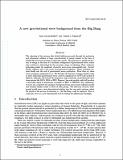Por favor, use este identificador para citar o enlazar a este item:
http://hdl.handle.net/10261/5461COMPARTIR / EXPORTAR:
 SHARE
BASE SHARE
BASE
|
|
| Visualizar otros formatos: MARC | Dublin Core | RDF | ORE | MODS | METS | DIDL | DATACITE | |

| Título: | A new gravitational wave background from the Big Bang |
Autor: | García-Bellido, Juan CSIC ORCID; García Figueroa, Daniel | Palabras clave: | Big Bang Gravitational Wave Background General Relativity and Quantum Cosmology Astrophysics High Energy Physics - Phenomenology |
Fecha de publicación: | 27-ene-2008 | Citación: | 17th Workshop on General Relativity and Gravitation in Japan (2008) | Serie: | IFT-UAM/CSIC-08-05 | Resumen: | The reheating of the universe after hybrid inflation proceeds through the nucleation and subsequent collision of large concentrations of energy density in the form of bubble-like structures moving at relativistic speeds. This generates a significant fraction of energy in the form of a stochastic background of gravitational waves, whose time evolution is determined by the successive stages of reheating: First, tachyonic preheating makes the amplitude of gravity waves grow exponentially fast. Second, bubble collisions add a new burst of gravitational radiation. Third, turbulent motions finally sets the end of gravitational waves production. From then on, these waves propagate unimpeded to us. We find that the fraction of energy density today in these primordial gravitational waves could be significant for GUT scale models of inflation, although well beyond the frequency range sensitivity of gravitational wave observatories like LIGO, LISA or BBO. However, low-scale models could still produce a detectable signal at frequencies accessible to BBO or DECIGO. For comparison, we have also computed the analogous background from some chaotic inflation models and obtained similar results to those of other groups. The discovery of such a background would open a new observational window into the very early universe, where the details of the process of reheating could be explored. Thus, it could also serve as a new experimental tool for testing the Inflationary Paradigm. | Descripción: | 20 pages, 8 figures.-- To appear in the Proceedings of the 17th Workshop on General Relativity and Gravitation (JGRG17), Nagoya (Japan), 3-7 December 2007.-- arXiv:0801.4109v1 [gr-qc] | URI: | http://hdl.handle.net/10261/5461 |
| Aparece en las colecciones: | (IFT) Comunicaciones congresos |
Ficheros en este ítem:
| Fichero | Descripción | Tamaño | Formato | |
|---|---|---|---|---|
| 0801.4109v1.pdf | 536,64 kB | Adobe PDF |  Visualizar/Abrir |
CORE Recommender
Page view(s)
378
checked on 23-abr-2024
Download(s)
163
checked on 23-abr-2024
Google ScholarTM
Check
NOTA: Los ítems de Digital.CSIC están protegidos por copyright, con todos los derechos reservados, a menos que se indique lo contrario.
